Pycnogonida
Sea spiders, Pantopoda
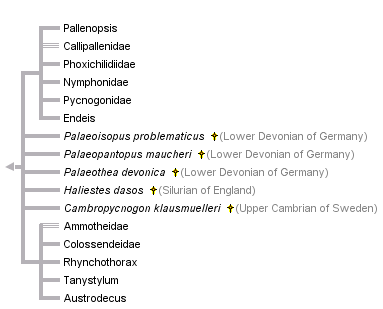


This tree diagram shows the relationships between several groups of organisms.
The root of the current tree connects the organisms featured in this tree to their containing group and the rest of the Tree of Life. The basal branching point in the tree represents the ancestor of the other groups in the tree. This ancestor diversified over time into several descendent subgroups, which are represented as internal nodes and terminal taxa to the right.

You can click on the root to travel down the Tree of Life all the way to the root of all Life, and you can click on the names of descendent subgroups to travel up the Tree of Life all the way to individual species.
For more information on ToL tree formatting, please see Interpreting the Tree or Classification. To learn more about phylogenetic trees, please visit our Phylogenetic Biology pages.
close boxReferences
Arango, C. P. 2002. Morphological phylogenetics of the sea spiders (Arthropoda: Pycnogonida). Organisms Diversity & Evolution 2:107-125.
Arango, C. P. 2003. Molecular approach to the phylogenetics of sea spiders (Arthropoda: Pycnogonida) using partial sequences of nuclear ribosomal DNA. Molecular Phylogenetics and Evolution 28:588-600.
Arnaud, F. and R. N. Bamber. 1987. The biology of Pycnogonida. Advances in Marine Biology 24:1-96.
Bain, B. A. 2003. Larval types and a summary of postembryonic development within the pycnogonids. Invertebrate Reproduction and Development 43:193-222.
Bamber, R. N. 2007. A holistic re-interpretation of the phylogeny of the Pycnogonida Latreille, 1810 (Arthropoda). Pages 295-312 in: Zhang, Z.-Q. & Shear, W.A., eds. Linnaeus Tercentenary: Progress in Invertebrate Taxonomy. Zootaxa 1668:1–766.
Bamber, R. N. and M. H. Thurston. 1995. The deep-water pycnogonids (Arthropoda, Pycnogonida) of the Northeastern Atlantic Ocean. Zoological Journal of the Linnean Society 115:117-162.
Bergström, J., W. Stürmer, and G. Winter. 1980. Palaeoisopus, Palaeopantopus and Palaeothea, pycnogonid arthropods from the Lower Devonian Hunsrück Slate, West Germany. Paläontologische Zeitschrift 54:7-54.
Child, C. A. 1998. The marine fauna of New Zealand: Pycnogonica (Sea Spiders). National Institute of Water & Atmospheric Research Biodiversity Memoirs 109:1-71.
Fahrenbach, W. H. 1994. Microscopic anatomy of Pycnogonida. 1. Cuticle, epidermis, and muscle. Journal of Morphology 222:33-48.
Fry, W. G. 1978. A classification within the pycnogonids. Zoological Journal of the Linnean Society 63:35-38.
Hedgpeth, J. W. 1978. Reappraisal of Palaeopantopoda with description of a species from Jurassic. Zoological Journal of the Linnean Society 63:23-34.
King, P. E. 1973. Pycnogonids. Hutchinson & Co., London.
Siveter, D. J., M. D. Sutton, D. E. G. Briggs, and D. J. Siveter. 2004. A Silurian sea spider. Nature 431:978-980.
Staples, D. A. 1997. 21. Sea spiders or pycnogonids (Phylum Arthropoda). Pages 1040-1072 in Marine Invertebrates of Southern Australia, Part III. S. A. Shepherd and M. Davies, eds. South Australian Research and Development Institute, Adelaide.
Stock, J. H. 1994. Indo-west pacific Pycnogonida collected by some major oceanographic expeditions. Beaufortia 1:17-77.
Vilpoux, K. and D. Waloszek. 2003. Larval development and morphogenesis of the sea spider Pycnogonum litorale (Ström, 1762) and the tagmosis of the body of Pantopoda. Arthropod Structure and Development 32:349-383.
Waloszek, D. and J. Dunlop. 2002. A larval sea spider (Arthropoda: Pycnogonida) from the Upper Cambrian 'Orsten' of Sweden, and the phylogenetic position of pycnogonids. Palaeontology 45:421-446.
Information on the Internet
- All About Sea Spiders (Pycnogonida). Bonnie A. Bain, Monash University.
- Pycnogonida - Macrobenthos of the North Sea. Netherlands Biodiversity Information Facility.
Title Illustrations

| Scientific Name | Nymphon gracile |
|---|---|
| Location | Hitra, Norway |
| Specimen Condition | Live Specimen |
| Source | Sea spider / Havedderkopp |
| Source Collection | Flickr |
| Image Use |
 This media file is licensed under the Creative Commons Attribution-NonCommercial-NoDerivs License - Version 2.0. This media file is licensed under the Creative Commons Attribution-NonCommercial-NoDerivs License - Version 2.0.
|
| Copyright |
© 2006 Asbjørn Hansen

|
| Scientific Name | Pycnogonum stearnsi |
|---|---|
| Location | Fitzgerald Marine Reserve, Moss Beach, California, USA |
| Specimen Condition | Live Specimen |
| Source | Mission Accomplished |
| Source Collection | Flickr |
| Image Use |
 This media file is licensed under the Creative Commons Attribution-NonCommercial-ShareAlike License - Version 2.0. This media file is licensed under the Creative Commons Attribution-NonCommercial-ShareAlike License - Version 2.0.
|
| Copyright |
© 2008 Ken-ichi Ueda

|
About This Page
Page copyright © 2002
 Page: Tree of Life
Pycnogonida. Sea spiders, Pantopoda.
The TEXT of this page is licensed under the
Creative Commons Attribution-NonCommercial License - Version 3.0. Note that images and other media
featured on this page are each governed by their own license, and they may or may not be available
for reuse. Click on an image or a media link to access the media data window, which provides the
relevant licensing information. For the general terms and conditions of ToL material reuse and
redistribution, please see the Tree of Life Copyright
Policies.
Page: Tree of Life
Pycnogonida. Sea spiders, Pantopoda.
The TEXT of this page is licensed under the
Creative Commons Attribution-NonCommercial License - Version 3.0. Note that images and other media
featured on this page are each governed by their own license, and they may or may not be available
for reuse. Click on an image or a media link to access the media data window, which provides the
relevant licensing information. For the general terms and conditions of ToL material reuse and
redistribution, please see the Tree of Life Copyright
Policies.
Citing this page:
Tree of Life Web Project. 2002. Pycnogonida. Sea spiders, Pantopoda. Version 01 January 2002 (temporary). http://tolweb.org/Pycnogonida/2539/2002.01.01 in The Tree of Life Web Project, http://tolweb.org/




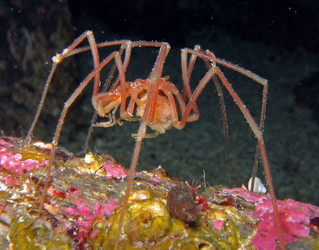
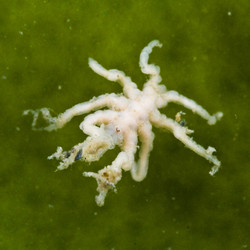
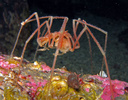
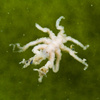

 Go to quick links
Go to quick search
Go to navigation for this section of the ToL site
Go to detailed links for the ToL site
Go to quick links
Go to quick search
Go to navigation for this section of the ToL site
Go to detailed links for the ToL site